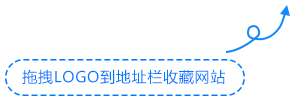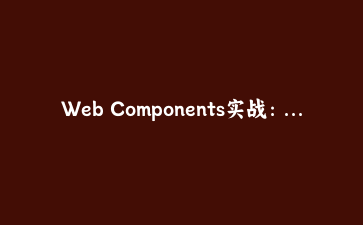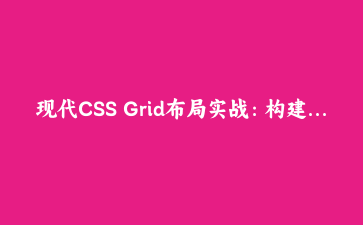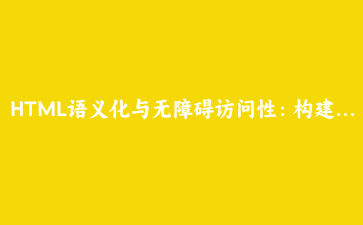Web Components技术概述
Web Components是一套不同的技术,允许您创建可重用的自定义元素(它们的功能封装在您的代码之外)并且在您的web应用中使用它们。作为一套浏览器原生支持的组件化方案,Web Components包含三个主要技术:Custom Elements(自定义元素)、Shadow DOM(影子DOM)和HTML Templates(HTML模板)。
核心技术解析
1. Custom Elements(自定义元素)
自定义元素让开发者能够定义自己的HTML标签,扩展HTML词汇表,创建具有自定义行为和样式的可重用组件。
2. Shadow DOM(影子DOM)
Shadow DOM提供了封装性,将标记结构、样式和行为隐藏起来,并与页面上的其他代码相隔离,保证不同部分不会发生冲突。
3. HTML Templates(HTML模板)
HTML模板允许您声明一些不在页面渲染的标记片段,然后可以在运行时实例化并插入到文档中。
环境准备与浏览器支持
现代浏览器(Chrome、Firefox、Safari、Edge)都已良好支持Web Components标准。您可以通过以下代码检测浏览器支持情况:
// 检测浏览器是否支持Web Components
if (!window.customElements || !window.ShadowRoot) {
console.error('您的浏览器不支持Web Components标准');
// 可以在这里加载polyfill
// document.write('<script src="https://unpkg.com/@webcomponents/webcomponentsjs@2.4.3/webcomponents-bundle.js"></script>');
} else {
console.log('浏览器支持Web Components');
}
创建第一个自定义元素
让我们从一个简单的自定义元素开始:创建一个可折叠的内容面板。
// 定义可折叠面板组件
class CollapsiblePanel extends HTMLElement {
constructor() {
super();
// 创建Shadow DOM
this.attachShadow({ mode: 'open' });
// 组件模板
this.shadowRoot.innerHTML = `
<style>
:host {
display: block;
border: 1px solid #ddd;
border-radius: 4px;
margin: 10px 0;
overflow: hidden;
}
.header {
padding: 12px 15px;
background-color: #f7f7f7;
cursor: pointer;
display: flex;
justify-content: space-between;
align-items: center;
font-weight: bold;
}
.content {
padding: 15px;
display: none;
}
.content.open {
display: block;
}
.icon::after {
content: '▼';
transition: transform 0.3s ease;
}
.icon.open::after {
transform: rotate(180deg);
}
</style>
<div class="header">
<slot name="title">默认标题</slot>
<span class="icon"></span>
</div>
<div class="content">
<slot>默认内容</slot>
</div>
`;
this.isOpen = false;
}
// 当元素被添加到DOM时调用
connectedCallback() {
this.header = this.shadowRoot.querySelector('.header');
this.content = this.shadowRoot.querySelector('.content');
this.icon = this.shadowRoot.querySelector('.icon');
this.header.addEventListener('click', () => this.toggle());
// 初始化状态
if (this.hasAttribute('open')) {
this.open();
}
}
// 切换展开/收起状态
toggle() {
if (this.isOpen) {
this.close();
} else {
this.open();
}
}
// 展开面板
open() {
this.content.classList.add('open');
this.icon.classList.add('open');
this.isOpen = true;
this.setAttribute('open', '');
this.dispatchEvent(new CustomEvent('panel-open', { bubbles: true }));
}
// 收起面板
close() {
this.content.classList.remove('open');
this.icon.classList.remove('open');
this.isOpen = false;
this.removeAttribute('open');
this.dispatchEvent(new CustomEvent('panel-close', { bubbles: true }));
}
// 观察属性变化
static get observedAttributes() {
return ['open'];
}
// 当属性变化时调用
attributeChangedCallback(name, oldValue, newValue) {
if (name === 'open') {
if (newValue !== null) {
this.open();
} else {
this.close();
}
}
}
}
// 注册自定义元素
customElements.define('collapsible-panel', CollapsiblePanel);
使用自定义元素
注册完成后,就可以在HTML中使用这个自定义元素了:
<collapsible-panel>
<span slot="title">项目介绍</span>
<p>这是一个使用Web Components创建的可折叠面板组件。</p>
<p>点击标题可以展开或收起内容区域。</p>
</collapsible-panel>
<collapsible-panel open>
<span slot="title">技术细节</span>
<ul>
<li>使用Shadow DOM实现样式封装</li>
<li>使用Slot实现内容分发</li>
<li>支持open属性控制初始状态</li>
<li>派发自定义事件通知状态变化</li>
</ul>
</collapsible-panel>
高级示例:数据表格组件
接下来创建一个更复杂的数据表格组件,支持排序、分页和搜索功能。
class DataTable extends HTMLElement {
constructor() {
super();
this.attachShadow({ mode: 'open' });
this.data = [];
this.currentPage = 1;
this.pageSize = 5;
this.sortField = '';
this.sortDirection = 'asc';
this.filterText = '';
}
connectedCallback() {
this.render();
this.loadData();
this.bindEvents();
}
// 加载数据(模拟API调用)
async loadData() {
// 实际项目中这里应该是API调用
// 模拟数据
this.data = [
{ id: 1, name: '张三', email: 'zhangsan@example.com', age: 28, department: '技术部' },
{ id: 2, name: '李四', email: 'lisi@example.com', age: 32, department: '市场部' },
{ id: 3, name: '王五', email: 'wangwu@example.com', age: 25, department: '设计部' },
{ id: 4, name: '赵六', email: 'zhaoliu@example.com', age: 29, department: '技术部' },
{ id: 5, name: '钱七', email: 'qianqi@example.com', age: 35, department: '人事部' },
{ id: 6, name: '孙八', email: 'sunba@example.com', age: 27, department: '市场部' },
{ id: 7, name: '周九', email: 'zhoujiu@example.com', age: 31, department: '技术部' },
{ id: 8, name: '吴十', email: 'wushi@example.com', age: 26, department: '设计部' }
];
this.renderTable();
}
// 渲染组件结构
render() {
this.shadowRoot.innerHTML = `
<style>
:host {
display: block;
font-family: Arial, sans-serif;
}
.data-table {
width: 100%;
border-collapse: collapse;
}
.data-table th, .data-table td {
border: 1px solid #ddd;
padding: 8px;
text-align: left;
}
.data-table th {
background-color: #f2f2f2;
cursor: pointer;
position: relative;
}
.data-table th:hover {
background-color: #e6e6e6;
}
.sort-indicator::after {
content: '↕';
margin-left: 5px;
font-size: 12px;
}
.sort-asc::after {
content: '↑';
}
.sort-desc::after {
content: '↓';
}
.controls {
margin-bottom: 15px;
display: flex;
justify-content: space-between;
align-items: center;
}
.search-box {
padding: 8px;
border: 1px solid #ddd;
border-radius: 4px;
}
.pagination {
margin-top: 15px;
display: flex;
justify-content: center;
gap: 5px;
}
.pagination button {
padding: 5px 10px;
border: 1px solid #ddd;
background: white;
cursor: pointer;
}
.pagination button.active {
background: #007bff;
color: white;
border-color: #007bff;
}
</style>
<div class="controls">
<input type="text" class="search-box" placeholder="搜索...">
<slot name="controls"></slot>
</div>
<table class="data-table">
<thead>
<tr>
<th data-field="name">姓名</th>
<th data-field="email">邮箱</th>
<th data-field="age">年龄</th>
<th data-field="department">部门</th>
</tr>
</thead>
<tbody></tbody>
</table>
<div class="pagination"></div>
`;
}
// 绑定事件
bindEvents() {
// 表头点击排序
this.shadowRoot.querySelectorAll('th').forEach(th => {
th.addEventListener('click', () => {
const field = th.dataset.field;
this.sortData(field);
});
});
// 搜索框输入
this.shadowRoot.querySelector('.search-box').addEventListener('input', (e) => {
this.filterText = e.target.value.toLowerCase();
this.currentPage = 1;
this.renderTable();
});
}
// 排序数据
sortData(field) {
if (this.sortField === field) {
this.sortDirection = this.sortDirection === 'asc' ? 'desc' : 'asc';
} else {
this.sortField = field;
this.sortDirection = 'asc';
}
this.renderTable();
}
// 渲染表格内容
renderTable() {
// 过滤数据
let filteredData = this.data.filter(item =>
Object.values(item).some(value =>
String(value).toLowerCase().includes(this.filterText)
)
);
// 排序数据
if (this.sortField) {
filteredData.sort((a, b) => {
const valueA = a[this.sortField];
const valueB = b[this.sortField];
if (valueA valueB) return this.sortDirection === 'asc' ? 1 : -1;
return 0;
});
}
// 分页
const totalPages = Math.ceil(filteredData.length / this.pageSize);
const startIndex = (this.currentPage - 1) * this.pageSize;
const pageData = filteredData.slice(startIndex, startIndex + this.pageSize);
// 渲染表格行
const tbody = this.shadowRoot.querySelector('tbody');
tbody.innerHTML = '';
pageData.forEach(item => {
const row = document.createElement('tr');
row.innerHTML = `
<td>${item.name}</td>
<td>${item.email}</td>
<td>${item.age}</td>
<td>${item.department}</td>
`;
tbody.appendChild(row);
});
// 更新表头排序指示器
this.shadowRoot.querySelectorAll('th').forEach(th => {
th.classList.remove('sort-asc', 'sort-desc', 'sort-indicator');
if (th.dataset.field === this.sortField) {
th.classList.add(`sort-${this.sortDirection}`);
} else {
th.classList.add('sort-indicator');
}
});
// 渲染分页控件
this.renderPagination(totalPages);
}
// 渲染分页控件
renderPagination(totalPages) {
const pagination = this.shadowRoot.querySelector('.pagination');
pagination.innerHTML = '';
for (let i = 1; i {
this.currentPage = i;
this.renderTable();
});
pagination.appendChild(button);
}
}
// 公共方法:更新数据
updateData(newData) {
this.data = newData;
this.currentPage = 1;
this.renderTable();
}
// 公共方法:设置分页大小
setPageSize(size) {
this.pageSize = size;
this.currentPage = 1;
this.renderTable();
}
}
// 注册数据表格组件
customElements.define('data-table', DataTable);
使用数据表格组件
<data-table>
<button slot="controls" onclick="alert('自定义操作')">导出数据</button>
</data-table>
<script>
// 可以通过JavaScript与组件交互
setTimeout(() => {
const table = document.querySelector('data-table');
// 添加新数据
table.updateData([
...table.data,
{ id: 9, name: '郑十一', email: 'zhengshiyi@example.com', age: 33, department: '财务部' }
]);
}, 3000);
</script>
Web Components最佳实践
- 命名规范: 使用连字符命名自定义元素(如:my-component)
- 渐进增强: 确保组件在JavaScript禁用时仍有基本功能
- 可访问性: 为组件添加适当的ARIA属性
- 性能优化: 使用MutationObserver监听DOM变化,避免频繁重渲染
- 浏览器兼容: 为不支持Web Components的浏览器提供polyfill
- 文档完善: 使用JSDoc为组件提供详细的API文档
与其他框架集成
Web Components可以与主流前端框架(React、Vue、Angular)无缝集成:
// 在React中使用Web Components
function ReactComponent() {
return (
<div>
<collapsible-panel>
<span slot="title">React中的Web Component</span>
<p>这是在React中使用自定义元素的示例</p>
</collapsible-panel>
</div>
);
}
// 在Vue中使用Web Components
<template>
<div>
<data-table ref="table">
<button slot="controls" @click="exportData">导出</button>
</data-table>
</div>
</template>
<script>
export default {
methods: {
exportData() {
const table = this.$refs.table;
// 调用组件方法
}
}
}
</script>
总结
Web Components为前端开发带来了真正的组件化解决方案,具有以下优势:
- 框架无关: 原生浏览器支持,不依赖任何框架
- 高度封装: Shadow DOM提供完美的样式和行为隔离
- 可重用性: 一次开发,随处使用
- 维护性: 组件逻辑集中,易于维护和测试
- 生态系统: 与现有前端生态完美兼容
通过本教程,您已经掌握了Web Components的核心概念和实际开发技巧。无论是简单的UI组件还是复杂的数据处理组件,Web Components都能提供强大而灵活的解决方案。随着浏览器标准的不断完善,Web Components将成为前端开发的重要技术方向。















